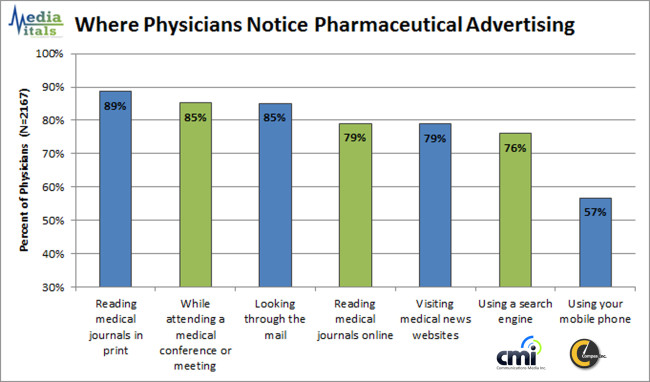When it comes to brand marketing, all we really want is to be noticed. Like a college freshman with a crush on a popular senior, we’re sending all the right signals and hoping they’ll look our way. But how do we know if our physician audiences are aware of our marketing efforts? Which media gets the most attention? And perhaps most importantly, what will lead to engagement?
In June 2013, CMI/Compas conducted its inaugural Media Vitals study to understand how doctors across multiple specialties are adopting technology in their professional setting and how it impacts a pharmaceutical brand team’s ability to communicate, capture and engage them through various channels. We wanted to know where doctors were noticing ads, where they were engaging with pharma, and how to improve what we deliver to these audiences. The extensive study of 60 questions was conducted across 21 physician specialties.
First, doctors use different media for different reasons and at different times. Print, mail and conference information is generally consumed when a physician is in “information-gathering” mode—dedicating substantial time to learning. Comparatively, when in “information-seeking” mode—looking for answers to specific questions—doctors tend to prefer digital channels. Physical pieces are bigger and have the tactile advantage of being physically handled—imagine a doctor relaxing with a journal on the weekend—versus digital tools that offer 24/7 on-demand information, such as during a patient visit. In other words, the “medium is the message.” A journal has a fixed number of pages and generally oriented for linear consumption. A digital tool, on the other hand, is not limited by a beginning or end and is oriented in a non-linear fashion so a user is much more likely to skip around and consume information in small doses. The actual content may be the same, but the medium dictates perception and consumption.
The majority of doctors (with the exception of oncologists and psychiatrists) recall ads from a multitude of channels, including print and online journals, conferences, search queries and digital websites. Mobile is rapidly growing in ad recall success with nearly three in 10 doctors reporting becoming aware of ads on their devices. We expect the ad message recall ratio in mobile to increase as publishers become more reliant on advertising support and pharma investment continues to increase.
Specifically, we found that, regardless of specialty, doctors state that they notice brand advertising most often while reading print journals (89%), attending medical conferences or meetings (89%), looking through the mail (85%). Comparatively, ads were noticed least while using their mobile phone (57%). Digital ads in online journals (79%), on medical news websites (79%) and in search engine results (76%) formed the middle tier of what stayed in the minds of doctors.
So what does this mean for marketers? Our research supports a multi-channel approach, since at least half of physicians frequently notice ads in a variety of ways—when reading journals and other information online, in print, while attending medical conferences or meetings, via search engines, or when looking through the mail. Channel neutrality is critical when serving up ads to physician audiences, and a diverse media plan is generally the optimal path to capture key audiences’ attention.
The college freshman crushing on the senior may get a date by sending an email, but might be more likely to be noticed if they also pass a note in class and somehow pop up in the campus newspaper. That isn’t to say that pharma brands need to “spray and pray,” offering messages everywhere possible. Rather, we recommend to our clients to choose their placements based on audience analyses of awareness, needs and consumption preferences. We need to cater messaging to physician needs and deliver in the way they want to be reached. For example, a third of oncologists (33%) prefer at least three channels for new product information and seem to skew toward podcasts (69%), information packaged with a journal (66%) and email (61%), while showing less interest in text messages (37%).
Extending the notion of channel neutrality beyond the paid ad placement, doctors are not just passive consumers of information in the form of pharma ads, but also seek out information. Our study found that, on average, doctors access professional information more than a dozen times a day on their desktop PCs, and slightly fewer times a day, on average, on their smartphones and tablets. The frequent use of mobile devices means that content must be format-friendly for all of these channels, and that media plans should include tangential non-personal promotion options such as HCP-tailored search optimization and email campaigns. We know from our own research as well as other industry findings that doctors search differently for health information than consumers, so pharma brands should invest in a targeted HCP search plan separately from consumer campaigns.
Like pharma marketers, that freshman mentioned earlier is hoping for engagement. And the best way to get there—for them and for us—is by getting to know the other party, and understand what they want.
A free excerpt of the digital findings of CMI/Compas Media Vitals is available by request.






